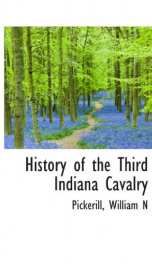history of the third indiana cavalry

Purchase of this book includes free trial access to www.million-books.com where you can read more than a million books for free. This is an OCR edition with typos. Excerpt from book: History of the Third Indiana Cavalry. OHAPTER I. The period for which seventy-five thousand troops had been enlisted was nearing its close and little had been accomplished in the way of ending the rebellion, while with each passing day the rebellion itself grew to more formidable proportions, and its promoters became more defiant and confident of their ability to cope with any force the government at Washington might send against them. This was the situation long before the term of enlistment of the first seventy-five thousand volunteers had expired. On the first day of July, 1861, came the battle of Bull Run at Manassas, Virginia, in which the best troops at the disposal of the government met a superior body of troops under General Beaure- gard, in which the government forces were completely routed and fled in confusion to the defenses of Washington, pursued by the victorious confederates with the evident purpose of taking possession of and holding the Capital of the country. They paused on the west bank of the Potomac, almost within cannon shot of where Congress was sitting, and made their camp there for months. The seriousness of the situation now took possession of the people both North and South. In the North the feeling of consternation among those who believed the government should be upheld gave place to a grim determination that the government must be sustained at all hazards, and in no section of the entire country was this feeling more intense than in the State of Indiana. From the very first Governor Morton was apparently impressed with the impending tragedy, and while he promptly equipped andhurried to the field the forty-six hundred and eighty men called for by President Lincoln's first proclamation, he foresaw that he would soon be called on for addition...
Users who have this book
Users who want this book
What readers are saying
What do you think? Write your own comment on this book!
write a commentif you like history of the third indiana cavalry try:
Other books by this author
Do you want to read a book that interests you? It’s EASY!
Create an account and send a request for reading to other users on the Webpage of the book!

